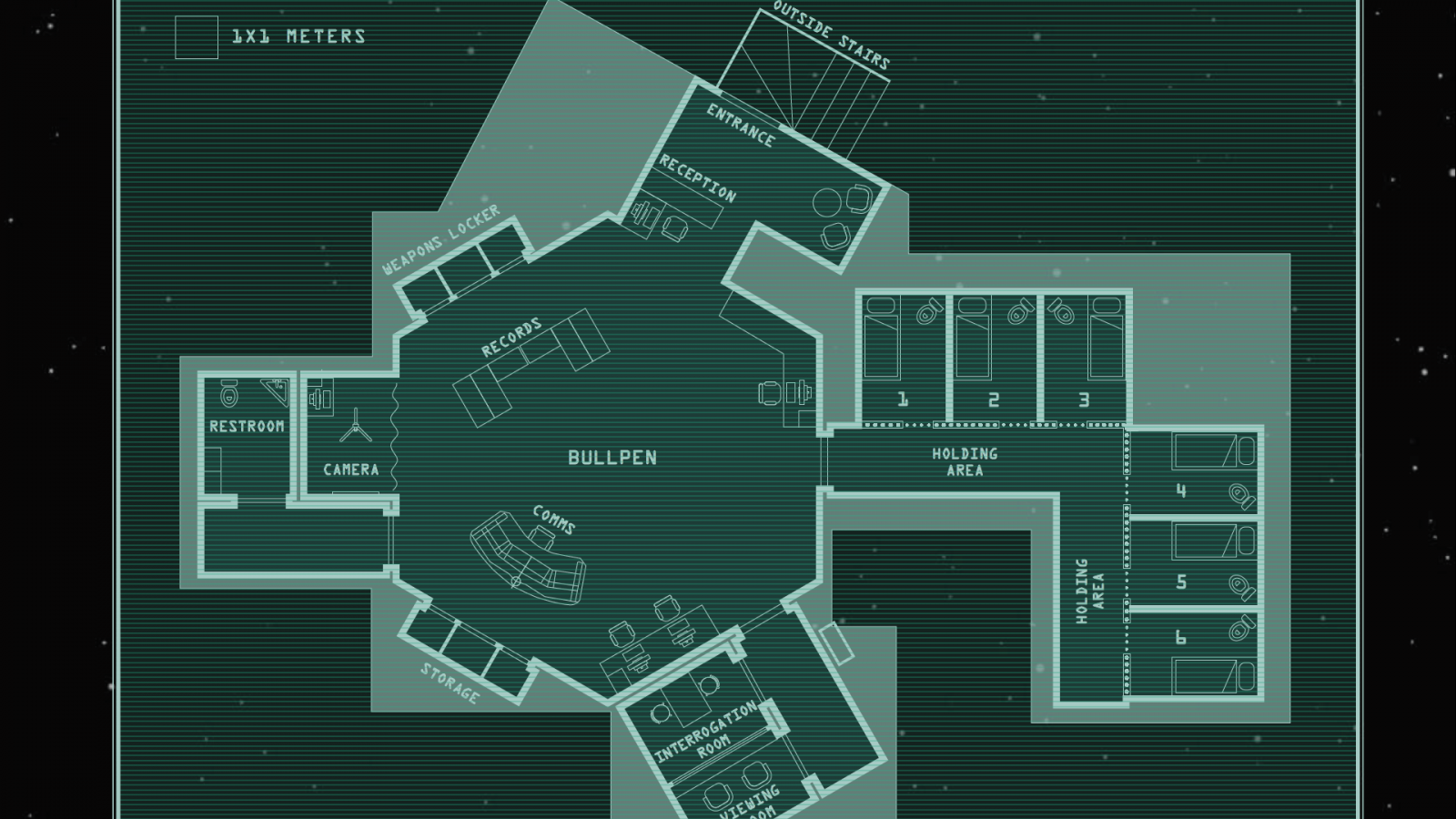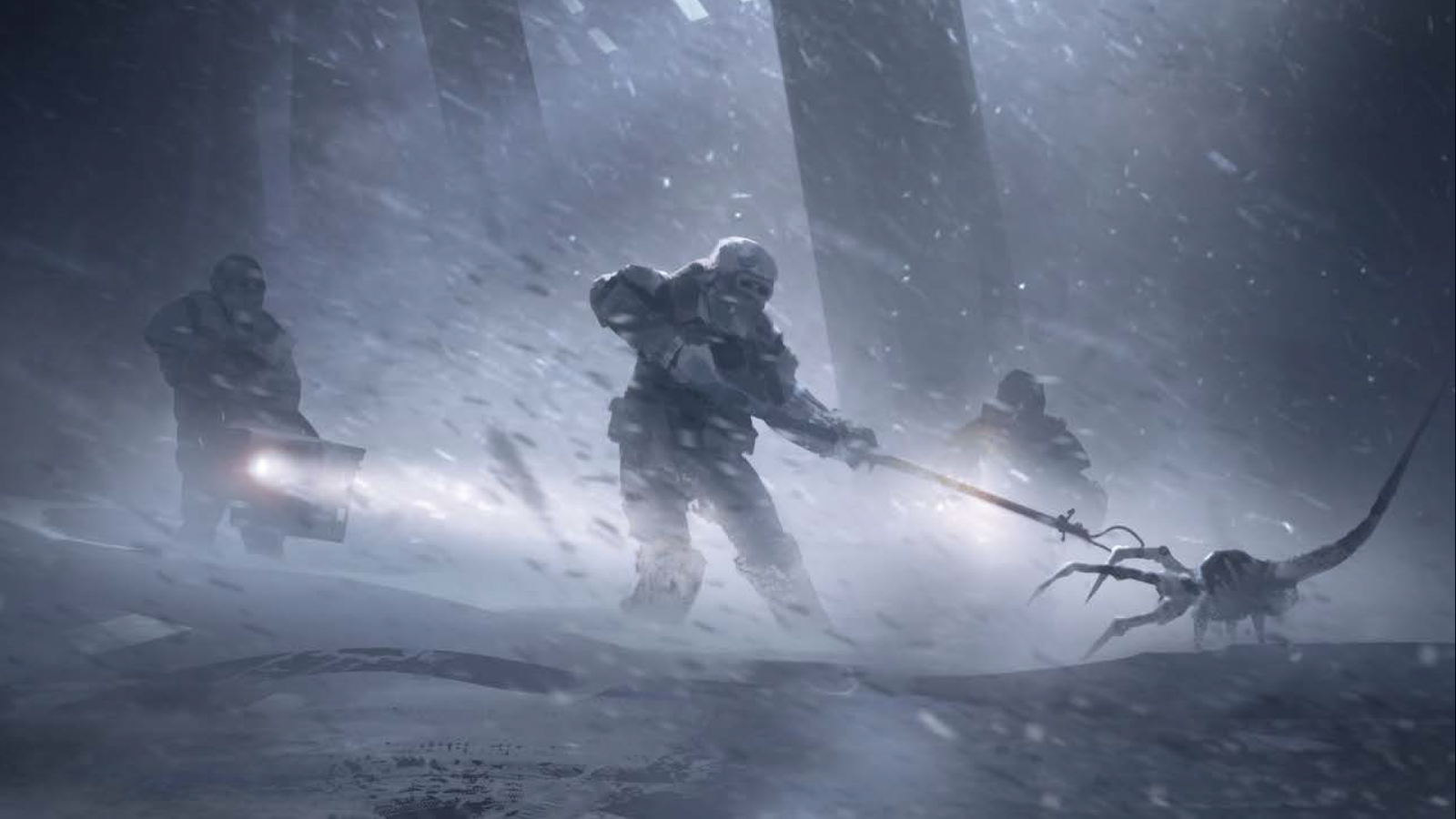
I found the Alien RPG starter set to be a worthy entry into the franchise, packing useful components into an introductory adventure to deliver a package that clever groups could use for weeks worth of play. Destroyer of Worlds, the new adventure set, requires either the starter set or the core book to use, as it doesn’t explain the game’s basic mechanics. It does include the Destroyer of Worlds adventure, agenda cards for all characters, gear and equipment cards, maps of locations and ships, and handouts for the adventure itself. Overall this set has a lot to recommend it, from the thoughtful design to a meaty adventure. I have my issues with it, but only some of you will share those points of displeasure.
The components, as with all Free League material, make in usefulness and attention to detail what they lack in durability. The card stock is lightweight and the scenario soft-back, but that does little to diminish the aesthetics and design, or how the one ultimately suits the other. One of the more impressive features of Alien is its cohesive art direction. Everything, from the maps to the equipment cards to the rules text, utilize a menacing color palette to constantly remind you of the hostility of space. These things aren’t just dark. They feel cast into the void itself, with pinpricks of stars which suggest lurking terror somewhere out of reach. The cards are informative, but not comforting. They display the same blocky, clinical tones of the setting’s industrial ships. Not only that, but these features are excellent at conveying information concisely, acting as a huge benefit to new players.

For those who have the starter set but not the corebook, Destroyer of Worlds grants a greater incentive to continue with your purchases: vehicle rules. The new set includes vehicle stats as well as rules for combat on the air and ground, so you will find the available rules slowly expanding as you obtain more sets. It’s a nice touch that doesn’t force players into buying the core book if they want to meaningfully expand the scope of their game.
Looking back on my prior review, I wish I discussed the player agenda cards with more detail, as I think they present some interesting conundrums from a design perspective. Each of the premade characters have set agenda cards that change throughout the adventure. These agenda change the character’s goals and reactions as the adventure progresses, and players are mechanically incentivized to follow these goals. The benefit to agenda cards is that it helps make the characters feel distinct. It also grants new players, who are the best target for premade one-shots with premade characters, help to roleplay their character and get invested in the scenario. The yang to this yin is that it deprives the players themselves of autonomy in choosing how to react to a given situation, or interpret how they think their character would react. It will be a useful roleplay tool for some and a frustrating handicap for others; I would say you could totally ignore this, but the fact that these are burdened with mechanical incentives makes it harder to argue that these are purely up to you table’s preference.
What does fit better is the similar but distinct Story Cards. These are also secret agenda, but come about due to stimuli from the story. Interacting with a hostile unknown alien might net you the Infected card, which will create some paranoia for the other players who don’t know what you were just handed. Because you generate these cards through your own choices rather than those of the designer, these feel more conducive to roleplay than the preset path laid out for you with agenda cards.
There is a secret about one of the PCs that I think will be the subject of some serious debate. I can see you loving it or hating it, but to avoid spoiling it outright, I will say that it’s effective from a horror standpoint, but does take agency away from the player in a way I know for a fact some people will not tolerate. It involves an event that happens before the adventure begins, and the player only learns about their own character partway through. It’s an effective revelation, and horror functions off of powerlessness, but I can see this crossing the line for a lot of players, learning that something so impactful had happened without their knowledge or involvement, now leaving them to contend with the consequences.
If there’s one central issue I take with Destroyer of Worlds, it’s tone. Mostly it’s consistent, but there are a few niggling areas that detract substantially from the overall story that Andrew E.C. Gaska is trying to tell.
To start with, the game seems to abandon the idea that you aren’t familiar with the Alien franchise, both in and out of game. The introductory handout adopts terms from the popular culture surrounding the franchise more directly than the franchise itself. It’s a military document ostensibly, but colloquially refers to “space truckers.” This opening text mentions that they are afflicted by strange “growths” but later refers to them as “impregnated.” Maybe it’s a mistranslation, but isn’t it an enormous logical leap to state that the crew were impregnated as a result of their contact? If this is a clue to the players, I don’t think it makes sense in the context of the fiction and it does ruin some of the surprise coming later in the adventure. In the same writeup they refer to an installation as being “nuked” which I find it difficult to believe would be considered useful or consistent military terminology.
But hey, you could write off all of those complaints as pedantic and nitpicky. What you are likely to have a problem with is this write-up from the book, directing you on how to deal with players asking too many questions during their briefing:

The writers should know better. For shame. First of all, as a standalone adventure that seems tailor made for new GMs, this is terrible advice. Calling your players smart assess and arresting them because they want tactical information on a mission that’s clearly suspicious and definitely lethal, is totally unacceptable. It makes for an adversarial tone and the advice itself is that you require your players to sit out large portions of the adventure for not playing by your rules. While not all military matters are need to know, and not every grunt is entitled to all intelligence, the context of this situation makes it reasonable that the players would ask for actionable intelligence before being sent into an escalating conflict. Moreover, some of the aforementioned “uncomfortable questions” are the types of things I think you would want a tactical team being aware of. For example, I don’t know, the presence of hostile biological organisms that need to be contained. Just as a random example.
The adventure itself is a jump in scale similar to that of Alien to Aliens, but different in the scope of what it presents to its audience. On its surface, Destroyer of Worlds is about a group of grunts going into a colony to investigate missing personnel. The backdrop involves an ongoing conflict between multiple factions, setting the stage for more political or military adventures should your players want to follow up on the adventure’s implications. Destroyer of Worlds takes intelligent pains to push the setting forward, as well as present it coherently to new players. It asks a crucially important question: now that factions are aware of the xenomorphs, what are the logical next steps? How does that shift the balance of power? The answers to those questions shape this adventure, and start to finally hint at where Free League hopes to take this franchise. Space horror is fine and dandy on its own, but adding in more complex political motivations into the mix takes this a few steps farther, and gives the franchise room to breathe, without relying totally on the plot device of an isolated team having to fend off xenomorphs.
In expanding that setting, the Destroyer of Worlds takes a step that I’m not sure holds up to scrutiny: some of this conflict centers on various factions and their access to oil, which I find scientifically questionable. This setting posits that there were massive oil shortages, but doesn’t that mean that the setting’s inhabitants would look elsewhere for energy? We’re already doing that now, and oil is not yet in drastically short supply. Maybe this is meant to enforce the rugged and dirty feel of the setting, where things still run on oil, but it strains my belief a little too far to think that a spacefaring society would still use it consistently. Keep in mind this isn’t plant oil or something synthetic. The book specifies it’s talking about petroleum, at least at first. The main setting is an oil extractor and refinery. This is compounded by the fact that the main installation is on a moon, which shouldn’t have any oil on it, unless they are talking about another energy source. I guess this could work, but doesn’t helium 3 make more sense? Or hell just a giant solar power array? Am I being pedantic? Does this matter at all? Well it sets the entire backdrop and context for this adventure, so it goes beyond obscure setting detail and into key information necessary for this adventure to happen. It could be that I’m missing a detail, or something is mistranslated, or they do mean that helium 3 or something similar is being extracted into oil, but this was my reaction on reading it through.

The scenario’s organization is almost but not quite great. There is no table of contents or index, but it does begin with a comprehensive summary of key events and a breakdown of how they will proceed. Be advised that there is a lot of text here, for all the events, locations, and characters, but not so much that you can’t use it proactively at the table. As long as you have conducted a thorough readthrough beforehand with your own bullet points, it should be a breeze to run this adventure.
Destroyer of Worlds has a lot of ideas, melding galactic politics with scale economies so well that I found the xenomorphs one of the less interesting elements of the adventure. Not that they aren’t interesting; the thoughtful changes they introduce to the setting are a welcome change of pace. Throughout this set, your players will get to investigate, roleplay, and engage in some tense combat scenarios that may just end up with all of you killed. If they do make it out alive, it will take every bit of intelligence and luck they have. My group ended the adventure just as their characters, bearing the burden of trauma and knowledge that made for a great story. There is a lot of reacting as well as acting on the part of the players, but all of it goes to set the stage for a greater adventure and a setting along with it.
Alien: Destroyer of Worlds
Good
Destroyer of Worlds is an articulate statement of where Free League sees its Alien franchise going: to the people. Its impacts ripple out to the wider galaxy, working as an entry point to a much more expansive adventure should you choose to keep playing. I have issues with some specifics of how this expansion presents and explains itself, but as a one shot with features you can use in future games, it makes up for its price tag immensely.
Pros
- A complete one box experience that can be useful long after its one-shot is complete
- New vehicle rules to enhance your toolbox
- An adventure rife with setting information and political ramifications
Cons
- Some issues with logic and presentation
- Agenda cards can deny autonomy to the players
- Advice to GMs lacks practical application
